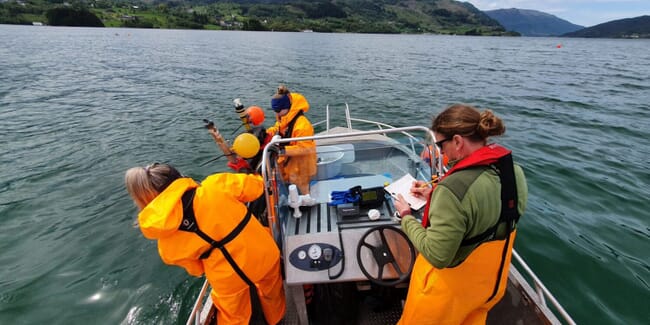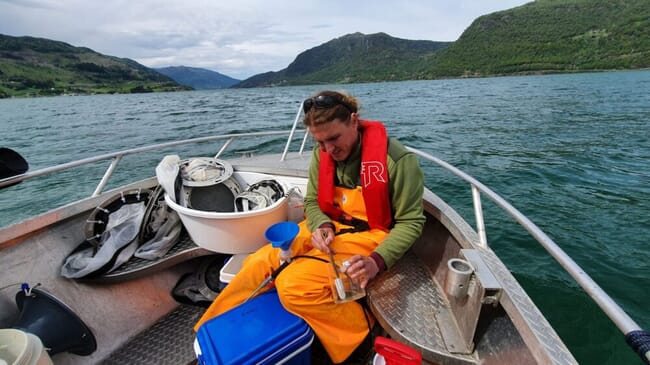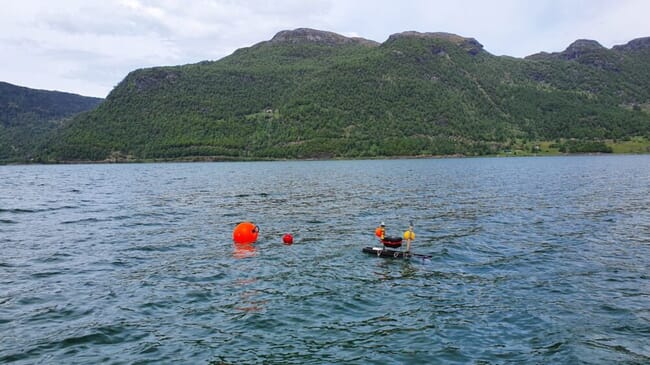
Researchers are using plankton samples to determine sea lice levels © Frode Fossøy
Researchers at NINA, the Norwegian Institute for Nature Research, and NTNU have developed a new method for monitoring salmon lice larvae along the coast. The lice trap is now being tested in the Hardangerfjord.
Salmon lice are one of the biggest challenges for the Norwegian aquaculture industry today and pose a threat to wild salmon. Authorities have introduced several measures to reduce lice levels in production facilities and infection pressure on wild fish.
A “traffic light” system is designed to ensure predictable and sustainable growth in the aquaculture industry. The system uses the infection pressure from salmon lice on wild salmonids as an environmental indicator to determine whether production in an area can increase or needs to be reduced.

A total of 12 lice traps have been set out in Etne and Rosendal municipalities in the Hardangerfjord this summer © Frode Fossøy
However, monitoring salmon lice is no small feat. The current management system uses a combination of statistical models that calculate the spread of infectious salmon lice larvae from fish farms and manual counts in the field to monitor the lice on fish.
Field monitoring is done either by catching wild salmon in trawls and purse seines, or by putting farmed salmon into so-called “guard cages” and counting how many lice have infested the fish after two weeks in the ocean.
Lice larvae captured in open sea
Researchers at NINA, the Norwegian Institute for Nature Research, have collaborated with NTNU to develop a new method for counting salmon lice larvae in the open ocean. This is ground-breaking work that can be scaled up and contribute to cost-effective monitoring of lice larvae along the entire Norwegian coast.

The lice trap is being tested in the open ocean © Frode Fossøy
The lice trap filters seawater and collects plankton. The plankton samples are analysed at NINA’s genetics lab, where the researchers have developed DNA-based methods for calculating how many salmon lice larvae are present per litre of seawater. Thus, the method can be used to calculate the density of lice larvae in the ocean.
“Experiments from our pilot studies along the coast have yielded very good results so far. This is the first major test of the method, which we’re doing in connection with the national monitoring of salmon lice in the Hardangerfjord this summer,” says Frode Fossøy, a senior researcher at NINA.
Spreading of salmon lice larvae analysed in Hardangerfjord
A total of 12 lice traps have been put out in Etne and Rosendal municipalities in the Hardangerfjord this summer. The Norwegian Institute of Marine Research already carries out ongoing salmon lice monitoring with guard cages, so the researchers can compare their data with the monitoring results from the Institute of Marine Research. Development of the new method will also help to calibrate the models used in the traffic light system and make the dispersal models even more accurate.
PhD candidate Nathan Mertz and master’s students Ingvild Tryggestad and Amanda Andersson at NTNU Sealab have collected large amounts of plankton from various localities in order to analyse the spread of salmon lice in the fjord system.
“These data will be very important and will complement the various national dispersal models for salmon lice developed by the Institute of Marine Research, SINTEF and the Norwegian Veterinary Institute. The method could become an important part of the traffic light system,” says Bengt Finstad, a professor at NTNU Sealab.




